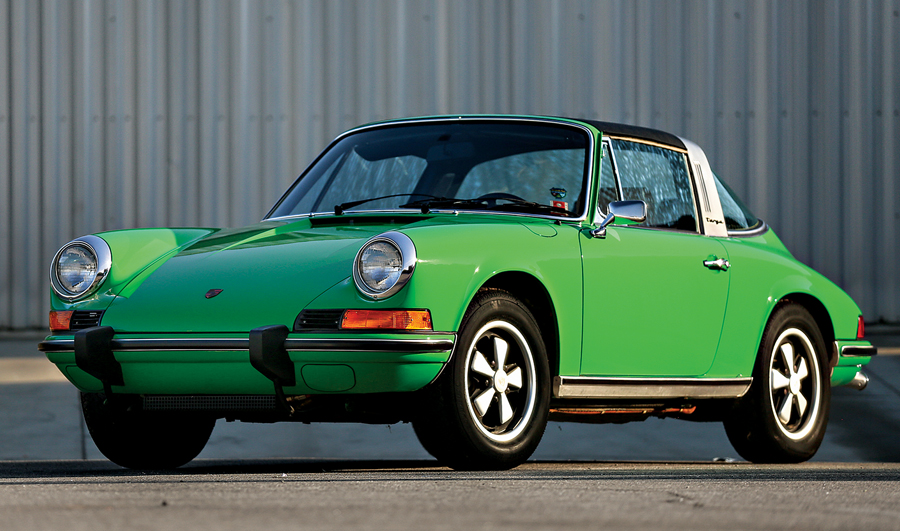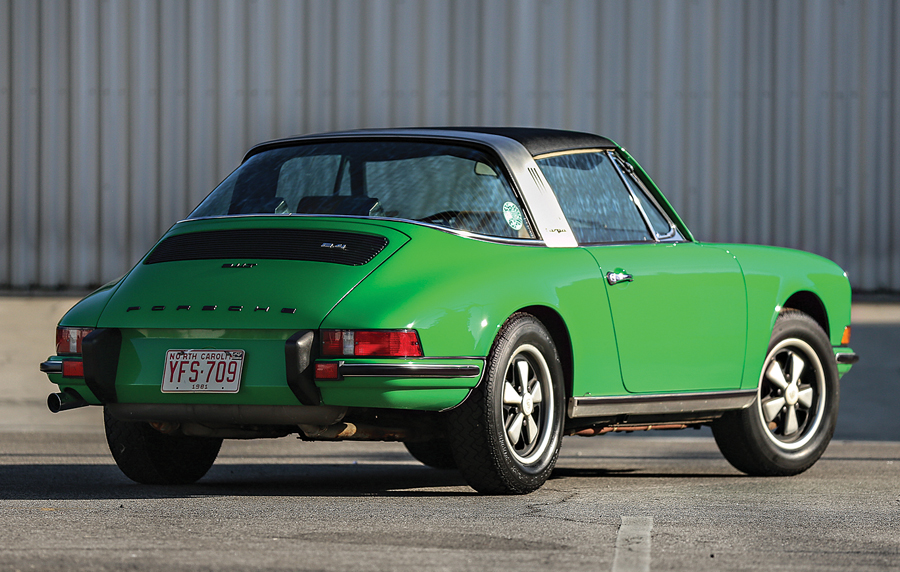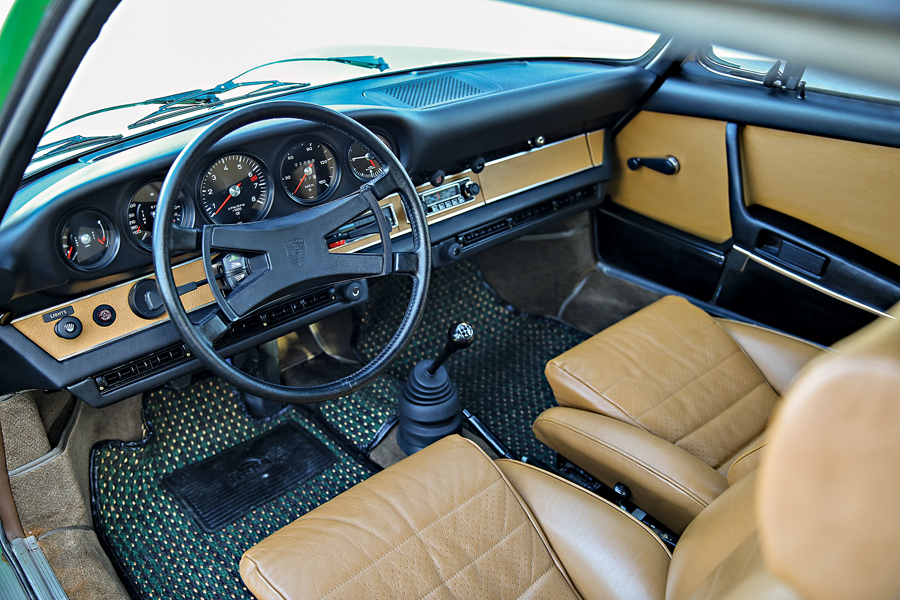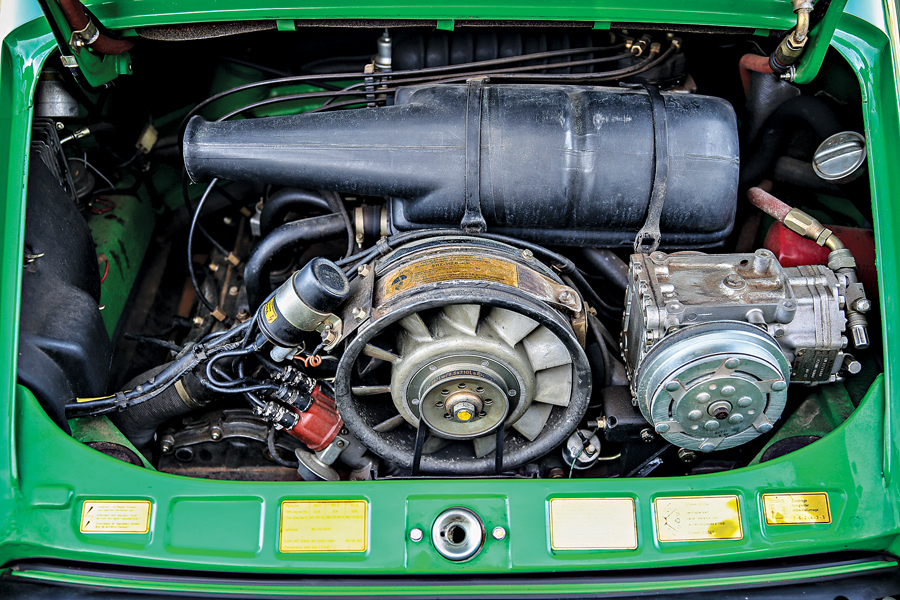SCM Analysis
Detailing
| Vehicle: | 1973 Porsche 911T 2.4 Targa |
| Years Produced: | 1973 |
| Number Produced: | 1,302 U.S.-spec CIS Targas; 13,471 for all 1973s |
| Original List Price: | $8,760 base price; $11,820 for this optioned-up example |
| SCM Valuation: | $59,000 |
| Tune Up Cost: | $1,100 with valve adjustment |
| Chassis Number Location: | Stamped into body panel above gas tank, passenger’s side in trunk; riveted aluminum tag on bottom threshold of trunk; federal compliance sticker on B-pillar of driver’s door |
| Engine Number Location: | Vertical stamping on fan-support base, facing passenger’s side |
| Club Info: | Porsche Club of America |
| Website: | http://www.pca.org |
| Alternatives: | 1970–73 Datsun 240Z, 1970–74 Alfa Romeo GTV 2000, 1971–75 DeTomaso Pantera |
| Investment Grade: | B |
This car, Lot 58, sold for $313,500, including buyer’s premium, at the Gooding & Company auction in Scottsdale, AZ, on January 19, 2018.
The 1973 911s are the end of an era that runs in a straight line from Porsche‘s Type 901 prototype, introduced at the Frankfurt Auto Show in September 1963.
Production started in 1964, when a bare 232 examples were manufactured — and then ramped up substantially in 1965. The renamed 911 became an almost instant sensation, the model name famously adopted after Peugeot made it known that they would not back off their French copyrights on all three-digit car-model names with a zero in the middle.
A separate model name for France made no sense, so the 911 became the first non-engineering-study number applied to a Porsche vehicle. The 911’s 4-cylinder little brother, the 912, also had a name made up in the marketing department. (For reference, and a good trivia tidbit, engineering-study Type 912 was the racing 917’s flat-12 engine.)
An iconic design refined and developed
The earliest 911s appear short and skinny to our eyes today, but they are well proportioned, and they set “the look” for all 911s produced ever since.
From 1964 through 1969, they carried 1,991-cc engines starting with 130 horsepower. The first substantial evolution was to add the uprated 911S in 1967 with 160 horsepower, a model that also introduced the iconic silver-and-black Fuchs forged-alloy wheels.
The next major move came in 1969, when Porsche increased the 911’s wheelbase by 2.2 inches, from 87 inches to 89.2 inches, while actually shaving the overall length a tiny bit.
Mechanical fuel injection arrives
More importantly, 1969 saw the advent of mechanical fuel injection to replace carburetors. This change allowed Porsche to meet the stricter U.S. emissions laws.
Finally, in 1969 Porsche moved to a three-model lineup, from the base 911T to a mid-range 911E, and finally the autobahn-crusher 911S. The new lineup delivered 125, 140 and 170 horsepower, respectively — and was the last year of the high-pitched-wailing 2-liter engines. Power differences between the three engines were due to carbs and cast-iron pistons and cylinders on most of the Ts vs. fuel injection and alloys on the E and S versions, plus compression ratio and camshaft changes, among other variables.
Curb weight barely moved between 1964 and 1969, at about 2,460 pounds.
Moving up the displacement curve
In 1971, Porsche increased the 911’s engine displacement for the first time, from 1,991 cc to 2,195 cc. The engine was now called a 2.2-liter and in the three models, produced 125, 155 and 180 SAE horsepower, respectively. Those engines kept the high-pitched wail, and the cars remained light enough to be great fun to drive. Never hugely popular with modern-day collectors, some of us believe the 2.2 is an ideal model to own for pure driving fun. And all 1971 911Ss came stock with Sport seats, which are otherwise a favorite and expensive option to find.
2,341-cc engine powered the last of the long-hoods
In 1972, recognizing a good thing, Porsche increased displacement again to 2,341 cc, called a 2.4-liter, with horsepower for the T/E/S at 140 (U.S. mechanical fuel-injection model, ROW was carbureted and 130 hp), 165 and 190 SAE. The 1972 model has had a sweet spot with collectors because it had the one-year-only, right-rear-fender outside oil filler. (And yes, gas station attendants liked to put gas in there — with disastrous results.)
U.S.-spec 1973 cars, on the other hand, not only lost the outside oil filler, they picked up those nasty-looking large black rubber bumper bombs, which quite often are relegated to the garbage can to be replaced by earlier-issue small metal ones.
The 2.4-liter models from both years are very popular now because they are the last “long-hood” or “low-bumper” 911s that traced their appearance back to the introductory cars of 1963–64. For 1974, new U.S. laws required higher bumpers with 5-mph shock absorbers inside, a change that resulted in a flat hood with no curve down to the now-raised bumper. Initial reception of the revised look was tepid, but improved markedly over time.
Perhaps less well accepted was the 1974–77 CIS K-Jetronic continuous-flow fuel-injection system that Porsche used on the new 2,644-cc 2.7-liter engine. While continuing to be a Bosch-manufactured unit, it lacked the snap and snarl of the old MIS systems. The new system’s occasional airbox-explosion engine fires generated further indignation.
What is a 1973½ CIS 911?
Which brings us to this interim model at Gooding’s auction. It is what we all call a 1973½ model to reflect that it was a mid-year changeover for just the 2.4-liter 911T model from manual fuel injection to the CIS continuous-flow fuel injection. The new engine developed the same 140 horsepower as the mechanical fuel-injected, U.S.-spec 911T.
The big news on our subject car was that it showed 3,370 miles. It was also well optioned with Sport seats, full leather, tinted glass and dealer-added air conditioning.
The car was pretty assuredly all original, including the paint — rare Kelly Green. Gooding had received the car in as-found-in-storage condition, and they did an excellent job preparing it for sale.
It glowed with originality.
On the debit side, the car needed a fulsome mechanical re-commissioning after many years of storage, and that easily can cost $25,000–$40,000. It also was the base-model 911T, and it had the oddball mid-year CIS engine. Finally, it was a Targa, not the market-preferred coupe.
A fair deal all around
Long-hood 911s in great blues, greens and oranges draw premium prices. With low mileage, they draw better-than-premium prices. With original paint, they draw BIG MONEY.
Put those three together and there could have been an explosion.
Gooding’s pre-sale estimate seemed light to some of us at $220,000–$260,000, but they had it right. With a hammer price of $285,000, or $313,500 after the 10% buyer’s premium, this Targa was easily $100,000 over a typical-but-still-collectible example.
This was a great car at a fair price. ♦
(Introductory description courtesy of Gooding & Company.)



